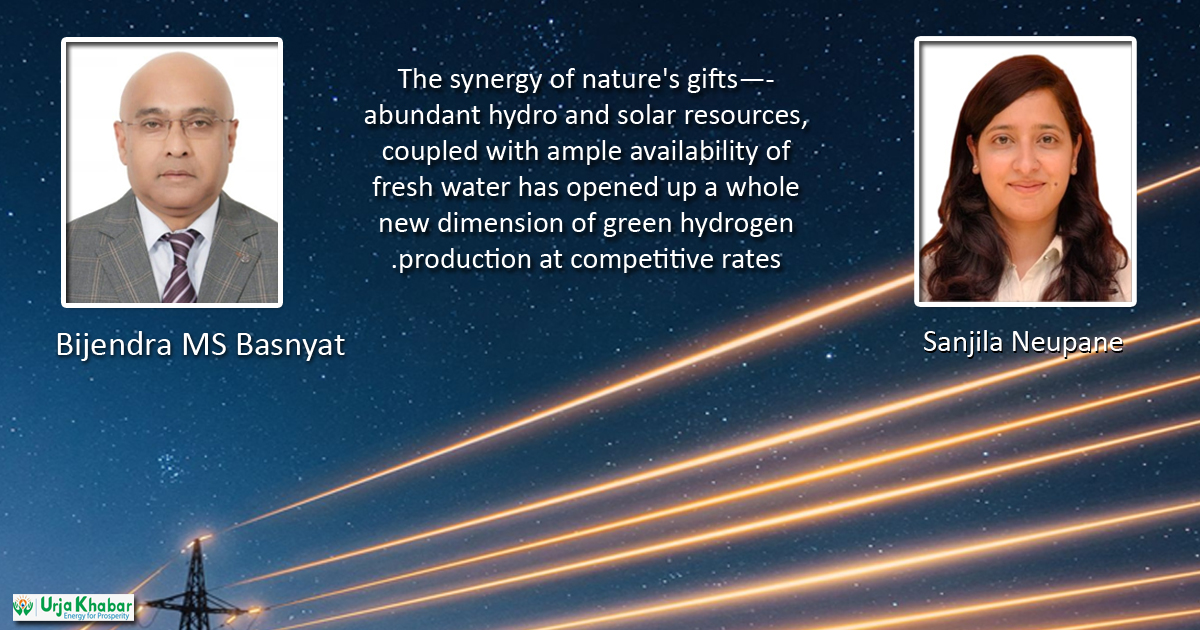
With a century-old legacy in hydropower development, Nepal now stands at a crucial crossroad. Once a pioneer in hydroelectricity, Nepal currently faces a complex dilemma: should it prioritize its own growth vis-a-vis increasing domestic consumption, or focus on export to minimize losses? This article delves into Nepal’s energy journey, tracing its path from the early days of the Pharping Hydropower Project to its current status as a seasonal electricity exporter. In doing so, it examines the economic and policy intricacies shaping Nepal's future in the energy sector.
Moreover, Nepal possesses a unique competitive advantage in producing green hydrogen, thanks to its abundant hydropower and solar resources. Its vast energy potential, fueled by numerous rivers, water bodies, and ample sunshine, offers renewable and reliable sources of electricity crucial for green hydrogen production. By leveraging this gifted natural asset, Nepal can realistically position itself as a key player in the regional energy market.

Diversifying Nepal’s Renewable Energy Portfolio
Nepal’s energy landscape is predominantly shaped by hydropower, with other renewable sources contributing only marginally. Despite the substantial hydroelectric potential, internal generation alone does not suffice year-round energy demands. Consequently, Nepal often relies on cross-border energy imports and/or seeks to reduce such seasonal imports by integrating grid-tied solar power. While hydropower is also a renewable energy source, excessive reliance on a single energy source poses risk. Diversifying Nepal’s energy portfolio by increasing the share of other renewables is essential and advisable as well. Current global trends underscore the importance of environmentally friendly and sustainable energy sources to meet growing energy needs. It is crucial for Nepal to align along this forward-looking approach.

While hydropower will continue to play a significant role in Nepal’s energy strategy, expanding the contribution of other renewable sources, come to think of it, is more than imperative. This diversification will not only help meet future domestic energy demands more reliably but also align Nepal with sustainability trends, enhancing both energy security and environmental stewardship.
A Century of Hydropower development
Nepal’s journey into electrical energy began with the inauguration of the Pharping Hydropower Project on May 22, 1911. This pioneering project, with an installed capacity of 500 kilowatts, illuminated Tudikhel and marked Nepal’s entry into the realm of hydroelectric power generation. Notably, this was South Asia’s second hydropower plant, following the world’s first in Appleton, Wisconsin, established in 18821.
Despite being an early adopter of hydroelectric technology, Nepal has not fully capitalized on its vast hydropower potential over the past century. Currently, Nepal’s installed hydropower capacity stands at 2,8972 MW. As a result, Nepal significantly lags behind regional neighbors: India and China, despite having embarked on hydropower development much earlier.
Miraculous Transformation: From Load Shedding to Seasonal Energy Export
In recent years, Nepal’s energy sector has undergone a remarkable transformation. It has evolved from the dark days of prolonged and acute load shedding to achieving energy security. Nepal Government’s 2016 policy paper: “National Energy Crisis Prevention and Electricity Development Decade,” outlines plans to incorporate renewable energy into the generation mix, aiming for 5-10% of installed grid capacity by 20263.
In line with this initiative, Nepal Electricity Authority (NEA) has recently floated a tender for competitive bids of 800 MW of utility-scale photovoltaic solar projects across Nepal. Furthermore, Nepal has taken initial steps towards green hydrogen by formulating a green hydrogen policy, which can be crucial for diversifying the country’s energy portfolio.
Past energy production trend indicates hydropower generation in Nepal surges during monsoon season due to increased water flow, resulting in production spike. Consequently, Nepal now exports approximately 4004 MW of this seasonal "surplus electricity" daily to India during the wet season at a bargain rate, highlighting its emerging role in the regional energy market.
Previously, this electricity was often wasted due to inadequate domestic demand. Now, it is being exported to minimize losses. If this surplus energy is properly utilized to boost industries and other revenue-generating sectors within Nepal, it could significantly enhance the national economy well beyond the earnings from energy sales.
Balancing Profitability and Complex Realities in Nepal's Electricity Trading
Nepal's electricity trading has seen both economic gains and complex realities. With the current average per unit export rate at Rs. 9.02 and import rate at Rs. 8.38, Nepal exported electricity worth Rs. 15.62 billion in the current fiscal year. However, the import value exceeded the export by Rs. 1.74 billion4 during the same fiscal year. Despite this, Nepal has made significant strides towards achieving seasonal energy security and has emerged as a potential energy exporter during the wet season only.
While Nepal's electricity trading appears profitable on the surface, a closer examination reveals nuanced complexities. The trading is conducted on buyer’s terms through competitive bidding in the Indian Energy Exchange Limited (IEX) market. Additionally, metering of traded electricity is done exclusively on the buyer’s side, and transmission line and distribution losses are not accounted for, which in turn reduce the actual profitability for Nepal.
This trading model also underestimates the needs of domestic industries, business communities, and households which end up paying higher costs as a result of inconsistent energy supply. Reliable and affordable electricity could help these sectors thrive, fostering economic growth, providing employment opportunities, and contributing to national taxation. However, the focus on export compromises upliftment of balanced domestic concerns.
While the government enjoys immediate financial benefits from energy trading, other critical sectors like agriculture, industry, and local communities unfortunately bear the costs. This imbalance calls for a more integrated energy policy to ensure that benefits are evenly distributed across all sectors.
Domestic Utilization vs. Export: A Dilemma
It is important to note that hydroelectric projects, which actually form the backbone of Nepal's electricity trade, are established only after overcoming numerous geographical and technical challenges, and often involve displacement of communities and households. Ideally, one might argue that this electricity should be consumed domestically to promote industrialization and support Nepal’s own nation-building efforts. However, on the contrary given Nepal's current circumstances, exporting energy to India appears to be a sensible approach to minimize energy spillage. This should not, however, be viewed as a long-term solution. Are we perpetually selling our hard-earned electricity on buyer’s terms and rates? Shouldn't Nepal prioritize using its resources for its own benefit, considering the significant investment of time and effort?
Currently, Nepal’s electricity demand matches the 2019 forecast, leading to significant daily fluctuations. Peak hours occur in the morning (6 am to 9 am) and evening (4 pm to 8 pm), as shown in the accompanying figure5. During these peak hours, Nepal relies on imported electricity to meet demand. Nepal's electricity trade pattern is characterized by a three-month export period, while for the remaining nine months, it relies on importing power from India to meet its domestic needs.
Although Nepal Electricity Authority (NEA) currently aims to export 600 MW of electricity, India has consented to importing just 500 MW. The usual annual renewal of energy trade agreement has been shortened to three months currently and is expiring on June 30, 20246. After this date, Nepal’s recourse will be limited to imports from India during daylight hours from 6 am to 6 pm6 only. This creates a significant challenge for Nepal, especially during the evening peak hours when domestic demand rises sharply.
Renewable sources such as solar power complement hydropower by generating electricity during seasons when hydropower production decreases. Integrating solar projects at each hydropower site would ensure consistent production capacity throughout the year.
Moreover, the government must introduce time-of-use pricing, incentivize off-peak usage through load management programs, and invest in energy storage solutions and other renewable sources like solar and green hydrogen. These measures would aim to balance consumption, reduce reliance on imports, and ensure a stable energy supply, thereby fostering resilience in Nepal’s energy sector for the benefit of all concerned.
Promises vs. Reality: Clean Energy Goals
Nepal’s commitment to green hydrogen and clean energy, articulated at global platforms like COP26 and COP28, must translate into tangible actions. However, Nepal remains hindered by poor infrastructure, weak policies, unstable government, and vague regulations. It is unfortunate that such commitments expressed in global forums quickly vanish.
Although not too long ago, a policy related to green hydrogen has been formulated, necessary developments have yet to follow. As stated in the budget for the fiscal year 2081/82, government funds have been earmarked for green hydrogen. Efficient utilization of this budget necessitates not only identification of suitable technology but also its effective implementation.
Contradictory Policies: Need for Holistic and Integrated Reforms
Nepal's national policy and implementation have consistently faced criticism for their contradictory approaches to holistic development. A prime example is the ambitious plan in the budget for fiscal year 81/82 to increase national per capita electricity consumption to 450 units, boost national capacity to 4500 MW, and export electricity to Bangladesh7. Yet, the same budget imposes increased tax on electric vehicles7, highlighting misaligned policies and directives from different government agencies.
Addressing these challenges requires a paradigm shift towards integrated policy reforms. Collaboration between the Ministry of Energy and other relevant ministries—such as Industry, Commerce, Supplies, Infrastructure, and Transport is imperative. This collaboration would foster a holistic approach to national development, leveraging available resources for multifaceted benefits.
Reconciling Profitability with Development Goals
Nepal's rise as an electricity exporter is commendable, but this profitability must be balanced with broader developmental goals. Embracing holistic strategies that prioritize domestic utilization alongside export ventures would ensure sustainable growth and foster inclusive development across sectors. Only through concerted efforts and integrated policymaking can Nepal harness its energy potential to drive comprehensive national advancement. It’s high time the government stops making grand promises and starts delivering tangible results. Government’s 'Make in Nepal' and 'Made in Nepal' campaigns should extend beyond mere mentions in budget plans8. These need to be prioritized and actively promoted through proper guidance and provision of incentives.
Conclusion: From Energy Importer to Energy Exporter
Nepal is abundantly rich in energy potential, boasting hydro, solar, and now the promising prospects of green hydrogen. The synergy of nature's gifts—abundant hydro and solar resources, coupled with ample availability of fresh water has opened up a whole new dimension of green hydrogen production at competitive rates. This energy source is already embraced by technology-oriented nations including our neighbors India and China, signaling a global shift towards sustainable energy solutions. Nepal is to green hydrogen what Saudi Arabia is to oil.
Energy consumption is intricately linked to economic growth, and Nepal finds itself at a crucial juncture: embrace green energy technology or risk falling behind. Therefore, the transition towards green hydrogen production not only ensures energy security but also opens doors for additional revenue generation through the export of green hydrogen, ammonia, and urea.
Footnotes
1. https://thehimalayantimes.com/business/pharping-hydropower-station-to-be-turned-into-an-energy-museum
2. https://myrepublica.nagariknetwork.com/news/private-sector-leads-hydropower-generation-over-government/
3. https://moewri.gov.np/storage/listies/May2020/white-paper-2075-with-annex02.pdf
4. https://www.spotlightnepal.com/2024/05/30/nepal-has-started-export-surplus-electricity-india-md-ghising/
5. https://pdf.usaid.gov/pdf_docs/PA00ZKSM.pdf
6. https://kathmandupost.com/money/2024/03/29/india-renews-electricity-export-permission-for-three-months
7. https://nepaleconomicforum.org/whats-inside-fiscal-budget-2081-82-key-highlights-and-programs/
8. https://mof.gov.np/uploads/document/file/1688901593_TC%20-%20EDIT%20-%20FY2023_24%20Budget%20Speech_R2.pdf
Authors of this article, Basnyat and Neupane are passionate energy sector enthusiasts specializing in engineering, procurement, construction of grid-tied solar plants (through Kushal Projects Nepal Pvt. Ltd.) and green hydrogen generation (through Greenzo Energy Pvt. Ltd.)
